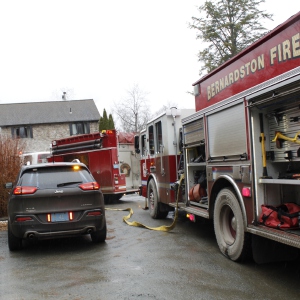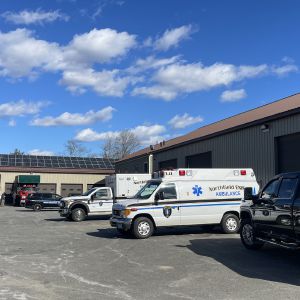My Turn: Inching toward zero carbon living

A Charge Point charging station in the Olive Street Parking Garage in Greenfield. STAFF FILE PHOTO/PAUL FRANZ
| Published: 01-24-2024 9:08 PM |
As a person greatly concerned about our climate, I want to tell you my story of pursuing living more lightly on the Earth professionally and personally.
In 1974 I was a “solar home” builder, then I became an employee of the Northeast Sustainable Energy Association (NESEA), and after that a retiree and volunteer for Greening Greenfield. Finally, last month I took two more personal steps toward getting off fossil fuels and using electricity, which emits zero carbon for everyone in Greenfield, unless you have opted out of Greenfield Light & Power. I’m not there yet, but I’m closer!
I moved to the area in 1970. In 1980, I gave up my dream of building myself a “solar home” and bought a drafty house in Greenfield, which I live in today. Since I was a carpenter, I started upgrading my home. First, I insulated the flat section of the roof, and then the slanty walls of the gambrel roof.
The downstairs walls were more challenging because they are cement block, not wood. On three sides I built walls inside so I could insulate them. The final side had a stairway against the wall, so I built a wall outside, and insulated and stuccoed that. But my house was still drafty.
In the 1990s I finally hired someone to find the drafts with a blower door (MassSave now does this), and discovered several gaping holes that let cold air into the floor joist system between the first and second floor. Still not quite comfortable, I upgraded the windows, and decided to change the heating distribution system from hot air to a radiant floor and bought a gas boiler to replace my dying gas furnace.
Today, my home is finally comfortable! And I enjoy heating bills of $750 a year for gas plus $750 a year for electricity for two people and a cat. My neighbor, with a carbon copy of my house, was paying $5,000 a year for oil in the 1980s. Just think of my savings — more than $80,000 in 20 years!
But I am still using fossil fuels!
Article continues after...
Yesterday's Most Read Articles
 Two dogs, three cats killed in Orange fire
Two dogs, three cats killed in Orange fire
 Leyden house fire reignites on Monday
Leyden house fire reignites on Monday
 PHOTOS: Hundreds participate in ‘Hands Off!’ standouts across Franklin County
PHOTOS: Hundreds participate in ‘Hands Off!’ standouts across Franklin County
 Plans to move Northfield EMS to Bernardston property fall through
Plans to move Northfield EMS to Bernardston property fall through
 Shelburne Selectboard determines police detective will retain job
Shelburne Selectboard determines police detective will retain job
 Bulletin Board: Greenfield's Savannah Thomas wins Knights of Columbus Hoop Shoot state title
Bulletin Board: Greenfield's Savannah Thomas wins Knights of Columbus Hoop Shoot state title
As for my gas cookstove, I have wanted to replace it for many years with an electric induction stove, because gas is not healthy. This has not been easy because I have a 24-inch stove, and induction stove/oven units have not been available. A few months ago, a friend told me she saw a 24-inch induction stove at Manny’s! I immediately looked into it, and found that I could get a $500 rebate from MassSave, but I needed to have an energy audit to get that rebate.
Finally, after a month, with rebate in hand, and a new 220v outlet, I have my new stove. In addition to the $500 from MassSave, there is now an IRA (Inflation Reduction Act) rebate from the feds of $840 or $420 depending on your income. To get rebates, the induction stove has to replace a gas one.
From 1989 to 2007, as a NESEA employer, I ran the Tour de Sol, a road rally event designed to demonstrate that we could drive electric vehicles recharged by renewably produced electricity. In 2001, with EVs not yet available, I bought my first hybrid Prius. Two years ago, I prepared for an EV and installed a 220v outlet on the outside of my house, looked for the “perfect” EV and waited until I needed a new car, but I waited too long.
My Prius did not pass inspection last May. I finally decided I wanted a Chevy Bolt, because it was smaller than others and less expensive, but I had to order it. Finally, I took delivery of my Bolt a few weeks ago.
Rebates for EVs are getting better and better. I learned that the federal rebate, which used to be a tax rebate, is now sent to the dealer, so if your EV is “made in America,” $7,500 will be taken off the price of your new car or $4,000 of a used one. Additionally, Massachusetts offers $3,500 to $5,000 rebates, and IRA offers $1,000 toward installing an EV charger.
While I’ve recently taken two giant steps, I still have one to go — my heating system. I have a plan to replace that in two years. Then I will finally be there! And feel better that I’m not contributing directly to climate emissions.
■You don’t have to do everything at once. Make a plan.
■Don’t wait until your car or heating system dies.
■Rebates: Check them carefully. All have income guidelines.
■Your home and stove: Mass Save.com plus IRA money, check rewiringamerica.org.
■Your car: MOR-EV for Mass Rebate plus IRA money, Rewiring America.
Nancy Hazard is a member of Greening Greenfield, a former builder, retired director of the Tour de Sol, and sits on the city’s Sustainable Greenfield Implementation Committee. She invites feedback at NancyHazard30@gmail.com.






 My Turn: ADUs and the politics of fear
My Turn: ADUs and the politics of fear My Turn: The war on us has begun
My Turn: The war on us has begun Jon Oltman: And the takeaway is?
Jon Oltman: And the takeaway is? Edward Schwerin: Trump regime not the answer
Edward Schwerin: Trump regime not the answer
